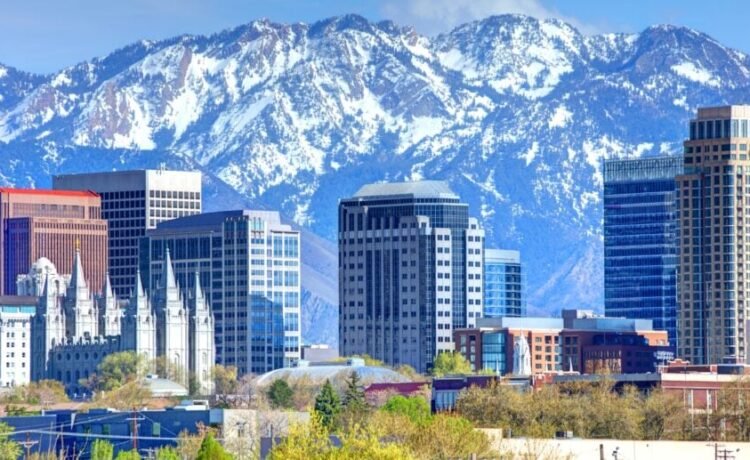Redfin once published data that showed for every 1% increase in tech workers in their sample of cities, there was an average 0.49% increase in home prices. Granted, the article was published almost 10 years ago and needs a refresh, but I think the underlying assumption still holds: When an area adds many tech jobs, home values increase.
Why is this? I took market data from CoStar and calculated which variables were correlated most with price growth over time. I found a strong relationship between increases in household income (and office employment) and increases in house prices.
The closer the correlation is to 1, the stronger the relationship. In the table, we can see that real estate prices in the top metropolitan areas are strongly correlated with household income, office employment (which includes tech jobs), and total employment, depending on the MSA.
Top 10 Cities With Highest Tech Job Growth
Next, I took historical job occupation data from the Bureau of Labor Statistics (BLS) and singled out job growth in the Computer and Mathematical Operations category (in other words, tech jobs). My criteria for selecting the top 10 markets were:
- Markets in the top 50% for total tech jobs (this excludes small markets).
- Markets with a number of tech jobs proportional to its size greater than the average national proportion (if a market had a small proportion of tech jobs, the results could be skewed by Facebook opening just one new data center in town—one company adding one new data center is not what I’d consider a “tech boom” for any market).
- Total employment over time must not be negative (there were some smaller markets that added a healthy number of tech jobs while their overall employment declined).
Top cities by five-year compound annual tech job growth
I ranked the remaining cities by their five-year compound annual tech job growth. This map shows the five-year growth of the top markets:
However, some of the markets with the highest growth from 2018-2023 actually had little-to-negative growth when measured from 2022-2023, such as Austin, Texas (1.77%); Provo, Utah (-5.74%); and Salt Lake City (-0.66%). This means their highest tech job growth periods happened before 2022 when the pandemic was raging.
While their five-year compound growth is impressive, there are other cities that have a similar five-year compound growth rate while also currently experiencing high one-year growth, as of the latest measurements published by the BLS.
Top cities by one-year tech job growth
I ranked each market by its one-year growth in tech jobs (from 2022-2023), while keeping its five-year compound growth into consideration. This map shows the results:
As you reference this map, consider the five-year compound growth. Indianapolis may have had a 9.36% one-year growth rate in tech jobs, but its five-year compound “growth” rate is -0.4%, which means over a five-year period, it had a net loss of technology jobs.
The top 10 tech growth cities
Before I calculated a top 10 list, I thought it was important to include the Location Quotient (LQ) in the rankings. According to the BLS, the LQ is the proportion of a specific job type relative to the average proportion for the U.S. Here is a direct quote from the BLS that helps explain the LQ:
“An LQ greater than 1 indicates an industry with a greater share of the local area employment than is the case nationwide. For example, Las Vegas will have an LQ greater than 1 in the Leisure and Hospitality industry because this industry makes up a larger share of the Las Vegas employment total than it does for the nation as a whole.”
In the case of tech job rankings, I filtered out all cities where the LQ was less than 1. I wanted to only include cities with a greater proportion of tech jobs than the national average.
Then I ranked the top cities with the highest one-year growth that also had a positive five-year compound growth rate. Here are the top 10 results:
Ogden, Sacramento, and Dallas stand out to me. Even more interesting is San Francisco’s overall growth in tech jobs, which directly contradicts many sources stating that it’s shrinking as a tech economy.
But what about cities with a high number of engineering and life sciences jobs? While I’ve answered the question of “which cities have the highest tech job growth,” I wanted to go one step further and examine the cities with the most job growth in STEM fields (science, technology, engineering, and mathematics).
Top 10 Cities With Highest STEM Job Growth
I started the analysis by adding all jobs in the Computer and Mathematical Occupations, Architecture and Engineering Occupations, and the Life, Physical, and Social Science Occupations, as defined by the BLS, to get the total STEM job count for each metro in 2018, 2022, and 2023.
Here’s a map of metros ranked by their five-year compound annual growth from 2018-2023. Cities weren’t included if they didn’t make the top 100 list or had negative growth in all four STEM occupations.
Like the tech growth map, keep in mind that while some metros had a solid five-year annual compound growth rate, they also may have had a one-year decline in STEM jobs, such as:
In addition, some places with a relatively weak five-year compound growth rate may have also seen high one-year growth, such as Los Angeles (+8.39%); Raleigh, North Carolina (+8.32%); and Oklahoma City (+9.09%), which may indicate they are now bouncing back from their losses during the pandemic (in Los Angeles’ case) or are adding STEM jobs faster than they did during the pandemic (in Raleigh and Oklahoma City’s case).
Now, if we only keep the top 50% of metros with the highest one-year and five-year growth in STEM jobs and then rank by one-year growth, we arrive at these top 10 metros for STEM employment growth:
Again, Sacramento and Ogden make the list (thanks to the high number of tech jobs each city added in the past year). These metros weren’t on my personal radar for investment before—but best believe they are now.
Here are some other markets to consider:
- Bellingham, Washington, is a two-hour drive from Seattle, and Greeley, Colorado, an 80-minute drive from Denver. These metros might be benefiting from people searching for a lower cost of living than their prime MSA (like Seattle or Denver), while still remaining in the general area.
- Rochester, Minnesota, is also about 90 minutes away from Minneapolis and is likely benefitting from the success of the Mayo Clinic, widely regarded as one of the best hospitals in the world.
- Charleston, South Carolina, is currently experiencing solid STEM employment growth, healthy population growth, and good price appreciation.
Final Thoughts
A rise in tech employment can lead to higher wages for a metropolitan area. This can result in real estate price appreciation over time. Buying and holding in an area with STEM employment growth could be an excellent strategy if only to ride a wave of appreciation over time.
Thanks to their growth in tech jobs, Ogden and Sacramento should stay on your radar. I would also keep the Research Triangle area (Raleigh-Durham-Chapel Hill) in mind, as its three major universities continue to produce an educated workforce ready to fill the area’s growing tech sector.
If you’d like help choosing a market to invest in based on variables like population growth, affordability, and unemployment rates, the BiggerPockets Market Finder may be helpful.
Find the Hottest Markets of 2024!
Effortlessly discover your next investment hotspot with the brand new BiggerPockets Market Finder, featuring detailed metrics and insights for all U.S. markets.

Note By BiggerPockets: These are opinions written by the author and do not necessarily represent the opinions of BiggerPockets.















